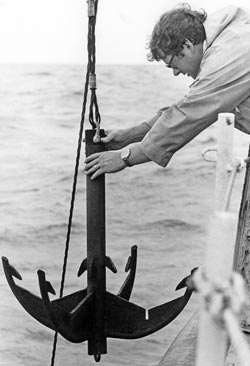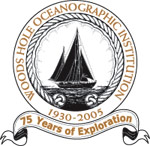This is an archived site. This site is no longer being maintained or reviewed for broken links.
Employee Portrait Gallery—George Tupper
 |
|
|
George Tupper attaches a grappling hook to the Oceanus trawl wire to drag for a mooring that refused to surface in 1979. (Photo by Dave Hosom)
|
“I’m an oceanographic generalist—at home in front of a computer or on the fantail of a ship,” George Tupper says. His areas of expertise encompass electronics, cruise logistics, hydrography, and mooring design, not to mention retrieving failed moorings.
This Minnesota native joined the Air Force right out of high school. His eight-year tour included five years with the BOMARC missile squadron at Otis Air Force Base, where he worked on missile guidance systems and radar. He was discharged on Friday, 14 July 1967, and came to work in the WHOI Buoy Group on Monday, 17 July 1967. His first assignment was to scrape battery acid and corrosion from a flooded current meter, but things got better from there. “I applied at the Woods Hole Coast Guard base at the same time,” he says. “A few months later, I had an offer to go there at substantially more pay, but by that time I was having so much fun at WHOI that I didn’t want to leave.”
While working on the development of current meters and other electronic sensors with Jim McCullough and Dick Koehler ashore, George began to lead Buoy Group cruises, beginning aboard Gosnold in July 1972. He also learned to use a computer program developed specifically to enable better design of surface and subsurface moorings. His first designs were for the Mid-Ocean Dynamics Experiment in 1973. Nearly 20 years later, he proposed adoption of an inverse-catenary (slack mooring with S-shaped lower portion) design for surface moorings to replace a somewhat unreliable taut-line design. The result was longer deployment times and fewer mooring failures. A 1992 Tupper-designed mooring off Vancouver survived seas as high as 53 feet. At George’s retirement party in December 2000, Rick Trask, a mooring operations supervisor, commented, “Throughout George’s career at WHOI he has worked at getting things to work better and last longer.”
George is among those who go to sea so frequently that they don’t track number of cruises or total time at sea, but he estimates he’s spent two to three months a year on cruises during his years at WHOI. One logistics story involves waiting with Dave Simoneau at the Fiji airport for vital acoustic release equipment they’d hand carried to be sure they could retrieve several current-meter moorings set along the equator in the Pacific. When it seemed to be missing after all the bags were offloaded from the 707, George talked his way onto the tarmac and into the baggage compartment, where he scrambled around until he found the missing items!
In his off hours, George learned to fly in the 1970s and has served as a designated WHOI pilot. He joined the Air National Guard in 1975 and for the next 22 years worked on F-106 and later F-15 radar systems at the 102nd Fighter Wing (Otis) one weekend a month. He’s put in long service on various WHOI benefits committees and task forces—and he’ll be off on another WHOI cruise this month.
[back]

